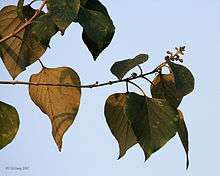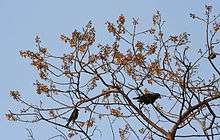Gmelina arborea
| Gmelina arborea | |
|---|---|
 | |
| Gmelina arborea tree plantation | |
 | |
| Gmelina arborea sapling from Mindanao, Philippines | |
| Scientific classification | |
| Kingdom: | Plantae |
| Clade: | Angiosperms |
| Clade: | Eudicots |
| Clade: | Asterids |
| Order: | Lamiales |
| Family: | Lamiaceae |
| Genus: | Gmelina |
| Species: | G. arborea |
| Binomial name | |
| Gmelina arborea Roxb. | |
| Synonyms | |
| |
Gmelina arborea, (in English beechwood, gmelina, goomar teak, Kashmir tree, Malay beechwood, white teak, yemane[2] ), locally known as gamhar, is a fast-growing deciduous tree, occurring naturally throughout greater part of India at altitudes up to 1,500 meters. It also occurs naturally in Myanmar, Thailand, Laos, Cambodia, Vietnam, and in southern provinces of China, and has been planted extensively in Sierra Leone, Nigeria, Malaysia, and on experimental basis in other countries as well. It is also planted in gardens and avenues.
Tree characteristics




Gmelina arborea is a fast-growing tree, which grows on different localities and prefers moist fertile valleys with 750–4500 mm rainfall. It does not thrive on ill-drained soils and remains stunted on dry, sandy or poor soils; drought also reduces it to a shrubby form. The tree attains moderate to large heights of up to 30 m, with a girth of 1.2 to 4 m. It has a chlorophyll layer just under the outer bark, which is pale yellow on the outside and white inside.
Gmelina arborea wood is pale yellow to cream-coloured or pinkish-buff when fresh, turning yellowish brown on exposure and is soft to moderately hard, light to moderately heavy, lustrous when fresh, usually straight to irregular or rarely wavy grained and medium course textured. Flowering takes place during February to April when the tree is more or less leafless whereas fruiting starts from May onwards up to June. The fruit is up to 2.5 cm long, smooth, dark green, turning yellow when ripe and has a fruity smell.
This tree is commonly planted as a garden and an avenue tree; growing in villages along agricultural land and on village community lands and wastelands. It is light demander, tolerant of excessive drought, but moderately frost hardy. It has good capacity to recover from frost injury. Gamhar trees coppices very well with vigorous growth. Saplings and young plants need protection from deer and cattle.
Geographical distribution
In India, Gmelina arborea occurs extensively from the Ravi eastwards in the sub-Himalayan tracts, common throughout Assam and adjoining areas of northern West Bengal, also in southern Bihar and Odisha, sporadically found in western and southern India and planted elsewhere on a large scale. Gamhar most commonly occurs in West Bengal forests in mixed forests.
Utilization of the species
Gmelina arborea timber is reasonably strong for its weight. It is used in constructions, furniture, carriages, sports, musical instruments and artificial limbs. Once seasoned, it is a very steady timber and moderately resistant to decay and ranges from very resistant to moderately resistant to termites.
Its timber is highly esteemed for door and window panels, joinery and furniture especially for drawers, wardrobes, cupboards, kitchen and camp furniture, and musical instruments because of its lightweight, stability and durability. It is also used for bentwood articles. In boat building it is used for decking and for oars. Gmelina arborea is a popular timber for picture and slate frames, turnery articles and various types of brush backs, brush handles and toys also for handles of chisels, files, saws, screw drivers, sickles etc. The wood is also used for manufacturing tea chests and general purpose plywood, blackboards, frame core and cross bands of flushdoor shutters. In the instrument industry gambhar timber is widely employed for the manufacture of drawing boards, plane tables, instrument boxes, thermometer scales and cheaper grade metric scales. It is also used in artificial limbs, carriages and bobbins. It is an approved timber for handles of tennis rackets, frames and reinforcements of carom boards and packing cases and crates. Gamhar is used in papermaking and matchwood industry too.
The Lion Throne, the most important, and last surviving, of the eight royal thrones of Myanmar, now in the National Museum in Yangon, is carved from Gmelina arborea wood.[3]
Gmelina arborea leaves are considered good for cattle (crude protein – 11.9%) and are also used as a feed to eri-silkworm.
'Kumizh tree' when burnt yields the whitest possible ash;mention is made by certain 'rock art enthusiasts' that this ash is one of ingredient in the semi solid white ochre used to draw the very ancient 'cave paintings' as old as 3,000 to 5,000 years or more; found in the dense forests of Tamil Nadu.[4]
Gmelina arborea wood
Medicinal uses
The root and bark of Gmelina arborea are claimed to be stomachic, galactagogue laxative and anthelmintic; improve appetite, useful in hallucination, piles, abdominal pains, burning sensations, fevers, 'tridosha' and urinary discharge. Leaf paste is applied to relieve headache and juice is used as wash for ulcers.
Flowers are sweet, cooling, bitter, acrid and astringent. They are useful in leprosy and blood diseases.
In Ayurveda, it has been observed that gamhar fruit is acrid, sour, bitter, sweet, cooling, diuretic tonic, aphrodisiac, alternative astringent to the bowels, promote growth of hairs, useful in 'vata', thirst, anaemia, leprosy, ulcers and vaginal discharge.
The plant is recommended in combination with other drugs for the treatment of snakebite and scorpion sting. In snakebite a decoction of the root and bark is given internally.
Chemistry
Lignans, such as 6“ - bromo - isoarboreol, 4-hydroxysesamin, 4,8-dihydroxysesamin, 1,4-dihydroxysesamin (gummadiol), 2-piperonyl-3-hydroxymethyl-4-(α-hydroxy-3,4-methylenedioxybenzyl)-4-hydroxytetrahydrofuran and the 4-O-glucoside of 4-epigummadiol, can be isolated from the heartwood of Gmelina arborea.[5] The parent compounds are arboreol or gmelanone.[6]
Umbelliferone 7-apiosylglucoside can be isolated from the root.[7]
Five constituents, isolated from the heartwood of G. arborea, (+)-7′-O-ethyl arboreol, (+)-paulownin, (+)-gmelinol, (+)-epieudesmin and (−)-β-sitosterol, show antifungal activity against Trametes versicolor.[8]
Local names
Gmelina arborea is locally called by different names in different languages:
- Languages of India:
- Assamese- Gomari
- Meghalaya (Garo) - Gamari, Gambare
- Bengali- gamari, gambar, gumbar
- Manipuri- Wang (ৱাং)
- Gujarati- Shewan, Sivan
- Hindi- gamhar, khamara, khumbhari, sewan
- Kannada- kooli mara, Shivane mara, kumbuda, kumulu
- Kasmiri- mara, shivani
- Malayalam- kumbil, kumbulu, kumilu, kumiska, pokki
- Marathi- shivan, siwan
- Nepali-khamaari
- Oriya- Bhadraparni, gambhari, kumar,ଗମ୍ଭାରୀ
- Punjabi- gumhar, kumhar
- Sanskrit-गम्भारी gambhari, सिन्धुपर्णी sindhuparni, सिन्धुवेषणम् sindhuveshanam, स्तूलत्वचा stulatvach
- Sinhala- Demata (දෙමට)
- Tamil- kumla, kumalamaram, kumil(spelled as "Kumizh" nowadays as the nearest phonetic), Venthekku, ummithekku
- Telugu- gumartek, gummadi, summadi
- Languages of South-east Asia:
- Burmese: ယမနေ [jamanei]
- Laotian: ໂຊ [sóː]
- Mon: ရမ္မာ [rɔmma]
- Filipino: yemane
- Indonesian: Jati putih
Gallery
-_fallen_flower_at_23_Mile%2C_Duars%2C_West_Bengal_W_Picture_341.jpg) Flowering canopy at 23 Mile near at Jayanti in Buxa Tiger Reserve in Jalpaiguri district of West Bengal, India.
Flowering canopy at 23 Mile near at Jayanti in Buxa Tiger Reserve in Jalpaiguri district of West Bengal, India.-_fallen_flower_at_23_Mile%2C_Duars%2C_West_Bengal_W_IMG_5898.jpg) fallen flower at 23 Mile near Jayanti in Buxa Tiger Reserve in Jalpaiguri district of West Bengal, India.
fallen flower at 23 Mile near Jayanti in Buxa Tiger Reserve in Jalpaiguri district of West Bengal, India.
References
- ↑ http://www.theplantlist.org/tpl/record/kew-91180
- ↑ "A tree species reference and selection guide". Archived from the original on 2011-09-30. Retrieved 2009-06-28.
- ↑ http://www.myanmar-image.com/enchantingmyanmar/enchantingmyanmar2-2/thrones.htm
- ↑ Gangadharan V. (2012 Mar 26) Materials behind the method The New Indian Express, page 2
- ↑ Novel hydroxy lignans from the heartwood of gmelina arborea. A.S.R. Anjaneyulu, A.Madhusudhana rao, V.Kameswara Rao and L.Ramachandra Row, Tetrahedron, 1977, Volume 33, Issue 1, Pages 133–143, doi:10.1016/0040-4020(77)80444-4
- ↑ The structures of lignans from Gmelina arborea Linn. A.S.R. Anjaneyulu, K.Jaganmohan Rao, V.Kameswara Rao, L.Ramachandra Row, C. Subrahmanyam, A. Pelter, R.S. Ward, Tetrahedron, 1975, Volume 31, Issue 10, Pages 1277–1285, doi:10.1016/0040-4020(75)80169-4
- ↑ An apiose-containing coumarin glycoside from gmelina arborea root. P. Satyanarayana, P. Subrahmanyam, R. Kasai and O. Tanaka, Phytochemistry, 1985, Volume 24, Issue 8, Pages 1862–1863, doi:10.1016/S0031-9422(00)82575-3
- ↑ Antifungal activity of constituents from the heartwood of Gmelina arborea: Part 1. Sensitive antifungal assay against Basidiomycetes. F. Kawamura, S. Ohara and A. Nishida, Holzforschung, June 2005, Volume 58, Issue 2, Pages 189–192, doi:10.1515/HF.2004.028
- GAMHAR (Gmelina arborea): Indian Council of Forestry Research and Education, Dehradun
- Crop index at the Purdue University